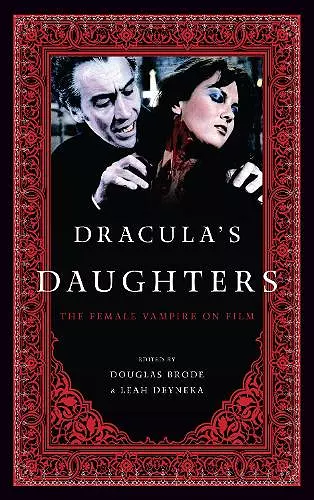Dracula's Daughters
The Female Vampire on Film
Douglas Brode editor Leah Deyneka editor
Format:Hardback
Publisher:Scarecrow Press
Published:24th Dec '13
Currently unavailable, and unfortunately no date known when it will be back

Almost as long as cinema has existed, vampires have appeared on screen. Symbolizing an unholy union between sex and death, the vampire—male or female—has represented the libido, a “repressed force” that consumed its victims. Early iconic representations of male vampires were seen in Nosferatu (1922) and Dracula (1931), but not until Dracula’s Daughter in 1936 did a female “sex vampire” assume the lead. Other female vampires followed, perhaps most provocatively in the Hammer films of the 1950s, ’60s, and ’70s. Later incarnations, in such films as Near Dark (1987) and From Dusk till Dawn (1996), offered modern takes on this now iconic figure.
In Dracula’s Daughters: The Female Vampire on Film, Douglas Brode and Leah Deyneka have assembled a varied collection of essays that explore this cinematic type that simultaneously frightens and seduces viewers. These essays address a number of issues raised by the female vampire film, such as violence perpetrated on and by women; reactions to the genre from feminists, antifeminists, and postfeminists; the implications of female vampire films for audiences both gay and straight; and how films reflected the period during which they were created. Other topics include female vampire films in relationship to vampire fiction, particularly by women such as Anne Rice; the relationship of the vampire myth to sexually transmitted diseases like AIDS; issues of race and misogyny; and the unique phenomenon of teen vampires in young adult books and films such as Twilight.
Featuring more than thirty photos spanning several decades, this collection offers a compelling assessment of an archetypal figure—an enduring representation of dark desires—that continues to captivate audiences. This book will appeal not only to scholars and students but also to any lover of transgressive cinema.
Vampires have long been a popular cultural icon in Western films and have more recently come back into the spotlight with the public fascination with the Twilight fiction series of books and movies. While men were the original stars, women vampires have been popular in movies and television as well since their debut in Dracula’s Daughters in 1936. In this volume the editors have compiled 16 essays that discuss women vampires in popular movies, television, book, and pop culture roles. A number of interesting topics are addressed within the essays, including the role of violence toward and by women, the reaction of these characters by feminists and antifeminists, and the role of race in the characterization of female vampires. The work includes more than 30 black-and-white photographs (mostly movie stills or movie posters) and a thorough introduction to the topic by editor Douglas Brode. This work can be recommended as a supplemental selection for academic film collections. * American Reference Books Annual *
For their third collaboration as coeditors (after Sex, Politics, and Religion in Star Wars, 2012, and Myth, Media, and Culture in Star Wars, 2012), Brode and Deyeka deconstruct female vampires in cinema. The 16 provocative, scholarly essays explore the historical and literary origins of the female vampire and chronicle her near century-long legacy in film. Individually, the essays provide comprehensive critiques of cinematic portrayals throughout the genre–from Gloria Holden's reluctant vampire Countess Zeleska in Dracula's Daughter (1936) to postfeminist-era iterations in such offerings as Let The Right One In (2008) and Twilight (2008)–while also analyzing how prevailing social perceptions of women of the time informed and influenced the making of these films. Collectively, the contributors paint a picture of a powerful, complex supernatural archetype that simultaneously elicits sympathy and desire in the viewer and is a universal and timeless metaphor for unleashed female sexuality and empowerment. Willson, Goldsmith, and Fonseca's scene-by-scene comparison of Dracula's Daughter and its 'remake' Nadja (1994) poignantly illustrates how film draws on the reinterpretive nature of the vampire myth as cautionary tale and the transformative essence of the vampire herself as she transgresses societal and cultural norms as well as life and death. Summing Up: Highly recommended. Upper-division undergraduates through faculty. * Choice Reviews *
ISBN: 9780810892958
Dimensions: 235mm x 160mm x 23mm
Weight: 544g
318 pages